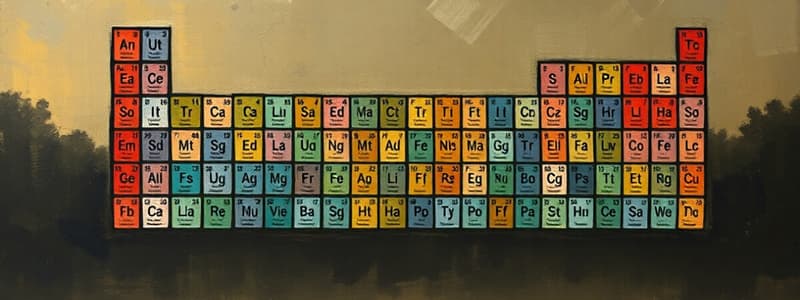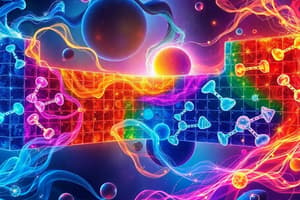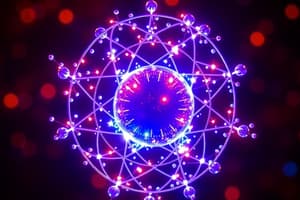Podcast
Questions and Answers
Which type of bonding involves the sharing of electron pairs between atoms?
Which type of bonding involves the sharing of electron pairs between atoms?
- Metallic bonding
- Covalent bonding (correct)
- Ionic bonding
- Hydrogen bonding
What is a characteristic property of ionic compounds?
What is a characteristic property of ionic compounds?
- They can be formed by the sharing of electrons
- They are usually soluble in polar solvents (correct)
- They conduct electricity in solid form
- They have low melting points
What is the electronic structure of a sodium ion (Na+)?
What is the electronic structure of a sodium ion (Na+)?
- 1s² 2s² 2p⁶ (correct)
- 1s² 2s² 2p⁶ 3p¹
- 1s² 2s² 2p⁶ 3s²
- 1s² 2s² 2p⁶ 3s¹
Which form of carbon is known for having a hexagonal lattice structure and excellent electrical conductivity?
Which form of carbon is known for having a hexagonal lattice structure and excellent electrical conductivity?
What type of structure do fullerenes form?
What type of structure do fullerenes form?
Flashcards
Periodic Table
Periodic Table
A chart organizing all known elements by atomic number and properties.
Electronic Structure
Electronic Structure
The arrangement of electrons around an atom's nucleus.
Ionic Bonding
Ionic Bonding
The electrostatic attraction between oppositely charged ions.
Covalent Bonding
Covalent Bonding
Signup and view all the flashcards
Metallic Bonding
Metallic Bonding
Signup and view all the flashcards
Study Notes
2.1 The Periodic Table
- The periodic table organizes elements by atomic number and recurring properties.
- Elements in the same group have similar chemical properties due to similar electron arrangements.
- Elements are arranged in periods, reflecting electron shell filling.
- Groups are vertical columns, periods are horizontal rows.
- Metals are generally on the left, non-metals on the right.
- Metalloids sit between metals and non-metals.
2.2 Electronic Structure
- Electrons orbit the nucleus in specific energy levels (shells).
- Each shell can hold a specific number of electrons, following the rule: 2n².
- The outermost shell determines the element's chemical properties.
- Valence electrons are electrons in the outermost shell.
- Electronic configurations describe the arrangement of electrons in shells.
2.3 Metals & Non-Metals
- Metals are good conductors of heat and electricity
- Metals are malleable and ductile (can be hammered into shapes, drawn into wires).
- Non-metals are generally poor conductors of heat and electricity.
- Non-metals are brittle.
2.4 Formation of Ions
- Ions are charged atoms.
- Atoms gain or lose electrons to achieve a full outer shell.
- Metals lose electrons to form positive ions (cations).
- Non-metals gain electrons to form negative ions (anions).
2.5 Ionic Bonding
- Ionic bonds form between oppositely charged ions.
- Electrostatic attraction holds the ions together.
- Ionic compounds are composed of a lattice of ions.
2.6 Ionic Compounds
- Ionic compounds have high melting and boiling points.
- They are often soluble in water.
- They conduct electricity when molten or dissolved in water.
2.7 Covalent Bonding
- Covalent bonds form when atoms share electrons.
- Covalent bonds often occur between non-metals.
- Sharing electrons allows atoms to achieve a full outer shell.
2.8 Types of Covalent Structures
- Covalent bonds can form simple molecular structures (small molecules).
- Covalent bonds can also form giant covalent structures (macromolecules).
2.9 Diamond & Graphite
- Diamond is a giant covalent structure with strong covalent bonds in a tetrahedral arrangement.
- Diamond is very hard and has a high melting point.
- Graphite is a giant covalent structure with layers of carbon atoms in a hexagonal arrangement.
- Graphite is soft and slippery, conducts electricity and has a high melting point.
2.10 Graphene & Fullerenes
- Graphene is a single layer of graphite, extremely strong and conductive.
- Fullerenes are molecules of carbon atoms arranged in closed cages.
2.11 Metallic Bonding
- In metals, valence electrons are delocalized.
- Delocalized electrons are free to move throughout the metallic structure.
- This sea of delocalized electrons holds the positive metal ions together.
- Metallic bonding explains the high melting points, conductivity (heat and electricity) and malleability of metals.
Studying That Suits You
Use AI to generate personalized quizzes and flashcards to suit your learning preferences.




